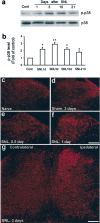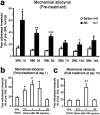p38 mitogen-activated protein kinase is activated after a spinal nerve ligation in spinal cord microglia and dorsal root ganglion neurons and contributes to the generation of neuropathic pain
- PMID: 12764087
- PMCID: PMC6741086
- DOI: 10.1523/JNEUROSCI.23-10-04017.2003
p38 mitogen-activated protein kinase is activated after a spinal nerve ligation in spinal cord microglia and dorsal root ganglion neurons and contributes to the generation of neuropathic pain
Abstract
The possible involvement of p38 mitogen-activated protein kinase activation in spinal cord and dorsal root ganglion (DRG) cells in the development of peripheral neuropathic pain has been explored. Ligation of the L5 spinal nerve (SNL) on one side in adult rats produces an early onset and long-lasting mechanical allodynia. This lesion results in activation of p38 in the L5 segment of the spinal cord, most prominently in the ipsilateral dorsal horn, starting soon after the lesion (<1 d) and persisting for >3 weeks. The activated p38 in the spinal cord is restricted entirely to microglia; phospho-p38 colocalizes only with the microglial marker OX-42 and not with either the neuronal marker neuronal-specific nuclear protein or the astrocyte marker GFAP. In contrast, SNL induces a delayed (>3 d) activation of p38 in the L5 DRG that occurs predominantly in neurons. Continuous injection of the p38 inhibitor 4-(4-fluorophenyl)-2-(4-methylsulfonylphenyl)-5-(4-pyridyl)-1H-imidazole (SB203580) via the intrathecal route, starting before the SNL surgery, reduces SNL-induced mechanical allodynia from day 1 to day 10, with maximal effects at early time points. Post-treatment with SB203580 starting on day 1 or on day 10 after surgery also reduces established mechanical allodynia. Because the reduction in neuropathic pain by p38 inhibition occurs before the appearance of p38 activation in DRG neurons, p38 activation in spinal cord microglia is likely to have a substantial role in the earliest phase of neuropathic pain. Coactivation of p38 in DRG neurons and spinal microglia may contribute to later phases of neuropathic pain.
Figures




Similar articles
-
Electroacupuncture attenuates spinal nerve ligation-induced microglial activation mediated by p38 mitogen-activated protein kinase.Chin J Integr Med. 2016 Sep;22(9):704-13. doi: 10.1007/s11655-015-2045-1. Epub 2015 Apr 6. Chin J Integr Med. 2016. PMID: 25847774
-
p38 activation in uninjured primary afferent neurons and in spinal microglia contributes to the development of neuropathic pain induced by selective motor fiber injury.Exp Neurol. 2007 Mar;204(1):355-65. doi: 10.1016/j.expneurol.2006.11.016. Epub 2006 Dec 21. Exp Neurol. 2007. PMID: 17258708
-
Tumor necrosis factor-alpha induces mechanical allodynia after spinal nerve ligation by activation of p38 MAPK in primary sensory neurons.J Neurosci. 2003 Apr 1;23(7):2517-21. doi: 10.1523/JNEUROSCI.23-07-02517.2003. J Neurosci. 2003. PMID: 12684435 Free PMC article.
-
[Contribution of primary sensory neurons and spinal glial cells to pathomechanisms of neuropathic pain].Brain Nerve. 2008 May;60(5):483-92. Brain Nerve. 2008. PMID: 18516970 Review. Japanese.
-
p38 MAPK, microglial signaling, and neuropathic pain.Mol Pain. 2007 Nov 1;3:33. doi: 10.1186/1744-8069-3-33. Mol Pain. 2007. PMID: 17974036 Free PMC article. Review.
Cited by
-
Impact of Hepatoma-Derived Growth Factor Blockade on Resiniferatoxin-Induced Neuropathy.Neural Plast. 2021 Feb 27;2021:8854461. doi: 10.1155/2021/8854461. eCollection 2021. Neural Plast. 2021. PMID: 33727914 Free PMC article.
-
SPOCK2 modulates neuropathic pain by interacting with MT1-MMP to regulate astrocytic MMP-2 activation in rats with chronic constriction injury.J Neuroinflammation. 2024 Feb 22;21(1):57. doi: 10.1186/s12974-024-03051-5. J Neuroinflammation. 2024. PMID: 38388415 Free PMC article.
-
A Single Injection of rAAV-shmTOR in Peripheral Nerve Persistently Attenuates Nerve Injury-Induced Mechanical Allodynia.Int J Mol Sci. 2023 Nov 2;24(21):15918. doi: 10.3390/ijms242115918. Int J Mol Sci. 2023. PMID: 37958901 Free PMC article.
-
Novel Therapeutic Targets in Neuroinflammation and Neuropathic Pain.Inflamm Cell Signal. 2014;1(3):e111. doi: 10.14800/ics.111. Inflamm Cell Signal. 2014. PMID: 26052540 Free PMC article.
-
Bullatine A stimulates spinal microglial dynorphin A expression to produce anti-hypersensitivity in a variety of rat pain models.J Neuroinflammation. 2016 Aug 30;13(1):214. doi: 10.1186/s12974-016-0696-2. J Neuroinflammation. 2016. PMID: 27577933 Free PMC article.
References
-
- Costigan M, Befort K, Karchewski L, Griffin RS, Da'Urso D, Allchorne A, Sitarski J, Mannion JW, Pratt RE, Woolf CJ ( 2002) Replicate high-density rat genome oligonucleotide microarrays reveal hundreds of regulated genes in the dorsal root ganglion after peripheral nerve injury. BMC Neurosci 3: 16. - PMC - PubMed
-
- DeLeo JA, Yezierski RP ( 2001) The role of neuroinflammation and neuroimmune activation in persistent pain. Pain 90: 1–6. - PubMed
-
- Fu KY, Light AR, Matsushima GK, Maixner W ( 1999) Microglial reactions after subcutaneous formalin injection into the rat hind paw. Brain Res 825: 59–67. - PubMed
Publication types
MeSH terms
Substances
Grants and funding
LinkOut - more resources
Full Text Sources
Other Literature Sources
Medical
Miscellaneous
